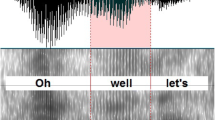Abstract
Clark and Fox Tree (2002) have presented empirical evidence, based primarily on the London–Lund corpus (LL; Svartvik & Quirk, 1980), that the fillers uh and um are conventional English words that signal a speaker’s intention to initiate a minor and a major delay, respectively. We present here empirical analyses of uh and um and of silent pauses (delays) immediately following them in six media interviews of Hillary Clinton. Our evidence indicates that uh and um cannot serve as signals of upcoming delay, let alone signal it differentially: In most cases, both uh and um were not followed by a silent pause, that is, there was no delay at all; the silent pauses that did occur after um were too short to be counted as major delays; finally, the distributions of durations of silent pauses after uh and um were almost entirely overlapping and could therefore not have served as reliable predictors for a listener. The discrepancies between Clark and Fox Tree’s findings and ours are largely a consequence of the fact that their LL analyses reflect the perceptions of professional coders, whereas our data were analyzed by means of acoustic measurements with the PRAAT software (www.praat.org). A comparison of our findings with those of O’Connell, Kowal, and Ageneau (2005) did not corroborate the hypothesis of Clark and Fox Tree that uh and um are interjections: Fillers occurred typically in initial, interjections in medial positions; fillers did not constitute an integral turn by themselves, whereas interjections did; fillers never initiated cited speech, whereas interjections did; and fillers did not signal emotion, whereas interjections did. Clark and Fox Tree’s analyses were embedded within a theory of ideal delivery that we find inappropriate for the explication of these phenomena.
Similar content being viewed by others
References
F. Ameka (1992) ArticleTitleInterjections: The universal yet neglected part of speech Journal of Pragmatics 18 101–118
F. Ameka (1994) Interjections R. E. Asher (Eds) The encyclopedia of language and linguistics Pergamon Press Oxford 1712–1715
E. R. Blackmer J. L. Mitton (1991) ArticleTitleTheories of monitoring and the timing of repairs in spontaneous speech Cognition 39 173–194 Occurrence Handle1841032
E. Brunswik (1934) Wahrnehmung und Gegenstandswelt. Grundlegung einer Psychologie vom Gegenstand her Deuticke Leipzig
A. Burkhardt (1998) Interjektion G. Ueding (Eds) Historisches Wőrterbuch der Rhetorik. Wissenschaftliche Buchgesellschaft Darmstadt 484–493
W. L. Chafe (1980) Some reasons for hesitating H. W. Dechert M. Raupach (Eds) Temporal variables in speech: Studies in honour of Frieda Goldman-Eisler Mouton The Hague 169–180
N. Chomsky (1965) Aspects of the theory of syntax MIT Press Cambridge, MA
H. H. Clark (1996) Using language Cambridge University Press Cambridge
H. H. Clark E. V. Clark (1977) Psychology and language: An introduction to psycholinguistics Harcourt Brace Jovanovich New York
H. H. Clark J. E. Fox Tree (2002) ArticleTitleUsing uh and um in spontaneous speaking Cognition 84 73–111 Occurrence Handle10.1016/S0010-0277(02)00017-3 Occurrence Handle12062148
H. H. Clark T. Wasow (1998) ArticleTitleRepeating words in spontaneous speech Cognitive Psychology 37 201–242 Occurrence Handle10.1006/cogp.1998.0693 Occurrence Handle9892548
H. Clinton (2003) Living history Simon & Schuster New York
D. Crystal R. Quirk (1964) Systems of prosodic and paralinguistic features in English Mouton The Hague
F. Goldman Eisler (1968) Psycholinguistics: Experiments in spontaneous speech Academic Press London
E. Holt (1996) ArticleTitleReporting on talk: The use of direct reported speech in conversation Research on Language and Social Interaction 29 219–245
H. Hörmann (1981a) Einfűhrung in die Psychologie Wissenschaftliche Buchgesellschaft Darmstadt
H. Hörmann (1981b) To mean – To understand: Problems of psychological semantics Springer-Verlag Berlin
James D. (1972). Some aspects of the syntax and semantics of interjections. Papers from the eighth regional meeting of the Chicago Linguistic Society(pp. 162–172). Chicago, IL: Chicago Linguistic Institute.
W. James (1890) The principles of psychology Henry Holt New York
P. Koch W. Oesterreicher (1994) Schriftlichkeit und Sprache H. Günther O. Ludwig (Eds) Schrift und Schriftlichkeit. Writing and its use. Ein interdisziplinäres Handbuch internationaler Forschung. An interdisciplinary handbook of international research De Gruyter Berlin 587–604
S. Kowal D. C. O’Connell (1995) ArticleTitleNotation und Transkription in der Gesprächsforschung KODIKAS/CODE; Ars Semeiotica: An International Journal of Semiotics 18 113–138
S. Kowal D. C. O’Connell (2000) ArticleTitlePsycholinguistische Aspekte der Transkription: Zur Notation von Pausen in Gesprächstranskripten Linguistische Berichte 183 353–378
S. Kowal D. C. O’Connell (2004) ArticleTitleInterjektionen im Gespräch Zeitschrift fűr Semiotik 26 87–102
W. J. M. Levelt (1989) Speaking: From intention to articulation MIT Press Cambridge, MA
H. Maclay C. E. Osgood (1959) ArticleTitleHesitation phenomena in spontaneous English speech Word 15 19–44
Merriam-Webster’s collegiate dictionary (11th ed.). (2003). Springfield, MA: Merriam-Webster.
D. Nűbling (2004) ArticleTitleDie prototypische Interjektion: Ein Forschungsprojekt Zeitschrift für Semiotik 26 13–48
D. C. O’Connell S. Kowal (2004a) ArticleTitleHillary Clinton’s laughter in media interviews Pragmatics 14 463–478
D. C. O’Connell S. Kowal (2004) ArticleTitleThe history of research on the filled pause as evidence of The written language bias in linguistics(Linell, 1982) Journal of Psycholinguistic Research 33 459–474 Occurrence Handle15614989
D. C. O’Connell S. Kowal C. Ageneau (2005) ArticleTitleInterjections in interviews Journal of Psycholinguistic Research 34 153–171 Occurrence Handle15991877
D. C. O’Connell S. Kowal E. J. Dill SuffixIII (2004) ArticleTitleDialogicality in TV news interviews Journal of Pragmatics 36 185–205
B. Pompino-Marschall (2004) ArticleTitleZwischen Tierlaut und sprachlicher Artikulation: Zur Phonetik der Interjektion Zeitschrift für Semiotik 26 73–86
M. Reisigl (1999) Sekundäre Interjektionen: Eine diskursanalytische Annäherung Peter Lang Frankfurt (Main)
V. L. Smith H. H. Clark (1993) ArticleTitleOn the course of answering questions Journal of Memory and Language 32 25–38 Occurrence Handle10.1006/jmla.1993.1002
A.-M. R. Spinos D. C. O’Connell S. Kowal (2002) ArticleTitleAn empirical investigation of pause notation Pragmatics 12 1–9
J. Svartvik R. Quirk (1980) A corpus of English conversation Gleerup Lund
C. Yang (2004) ArticleTitleInterjektionen im Sprachvergleich: Deutsch versus Chinesisch Zeitschrift fűr Semiotik 26 49–72
W. Wundt (1900) Völkerpsychologie Erstes Buch: Die Sprache. Engelmann Leipzig
Author information
Authors and Affiliations
Corresponding author
Rights and permissions
About this article
Cite this article
O’Connell, D.C., Kowal, S. Uh and Um Revisited: Are They Interjections for Signaling Delay?. J Psycholinguist Res 34, 555–576 (2005). https://doi.org/10.1007/s10936-005-9164-3
Issue Date:
DOI: https://doi.org/10.1007/s10936-005-9164-3




